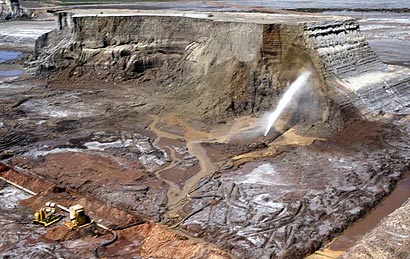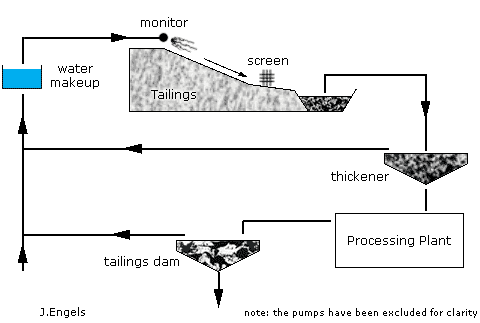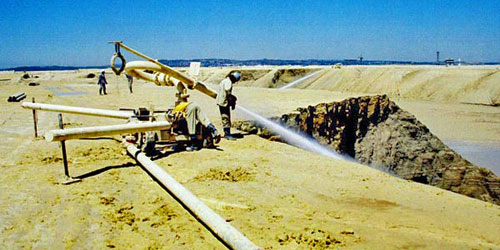Hydraulic mining of tailings
Hydraulic mining of tailings

Figure 1: Kaltails Project, Kalgoorlie, Western Australia (Courtesy of Newmont)
Hydraulic mining monitors used today were first developed back in the early sixties by English China Clays, Cornwall, England. The technology has been used on soft rock applications and on old tailings dams to either move or reprocess the stored material. The monitor uses high pressure water to erode the tailings in sections, washing the material downstream which is collected in a sump. Tailings dams are generally segregated by the coarseness of the material (coarse fraction near the spigot) and if a particular area of a dam is too coarse for pumping then blending is required. Once the required density is obtained in the sump and screening has prevented large objects from passing, the slurry is then pumped to thickeners and the underflow is reprocessed in the plant. The tailings are then stored in a tailings impoundment (Cuevas, Jansson et al.). A typical flow sheet for the reprocessing of tailings is shown below in figure 2.

Figure 2: Simplified diagram showing the hydraulic re-mining of tailings
It can be noted that the use of hydraulic mining for tailings can be to either reprocess the waste, mine the waste as a product, or for moving of the tailings to a more suitable location. Some tailings impoundments are hydraulically mined to not just process the tailings but to re-site them for environmental reasons. This is an affective method and can take a shorter time than mechanical excavation, depending on the density and particle sizes of the tailings.
Many of the old tailings dams around Johannesburg in South Africa have been remined using hydraulic monitors.

Figure 3: Manual hydraulic monitor on a tailings facility in South Africa (Courtesy of Fraser Alexander)
Case Studies
Kaltails project, Kalgoorlie, Western Australia
The Kaltails project was established to reprocess and move tailings dumps from the Boulder and Lakewood areas of the city of Kalgoorlie. The operations ceased in September 1999 and had been ongoing for just over a decade. The tailings dumps were hydraulically mined, reprocessed and stored in an engineered impoundment located 10km south east of Kalgoorlie. From the 60 million tonnes of tailings mined 695,000 ounces of gold was recovered by Carbon-in-Circuit (CIC) and Carbon-in-Pulp (CIP) leach and absorption circuits (Kaltails 1998; Normandy 1998).
Of the 333 hectares of land that was hydraulically mined, 262 hectares will be used for waste rock storage from the Kalgoorlie Consolidated Gold Mines (KCGM) superpit. The remaining 71 hectares have been contoured, seeded and revegetated.
See the Kaltails casestudy in more detail here.
Disputada Mine, Chile
The mine had three tailings dams that needed to be moved for environmental reasons. Two of these deposits were located in a steep narrow valley with the third deposit being located on the side of a valley.
The use of hydraulic monitors was considered as the only economical option as blending of the coarse fraction with the middlings and fines allows pumping of the tailings. However, the tailings were mixed with rock deposited during the construction of the impoundment and the subsequent impoundment division to form road ways. A small amount of rock was deposited from avalanche scree from the steep valley sides. The rock was removed by mechanical methods that had to work in dry conditions. This posed a problem for the hydraulic operation which was solved by having two mining areas to allow mining, drying and then rock removal. Dredging of the material in the dams would have caused damage to the mechanical equipment and pumps, also dry load and haul was considerably more expensive than hydraulic mining.
A production rate of 19,000 tonnes per day over an 8 month annual cycle was required to make the operation a success. Mining during the winter months posed hazards from avalanches, blizzards and freezing of pipelines and mechanical equipment (Cuevas, Jansson et al.).
During the mining operation the screened material was pumped to a header tank almost 5 km away at a height elevation of 200 m. From the header tank the tailings were gravitational fed to a new tailings impoundment 50 km away.
See the Disputada casestudy in more detail here.
